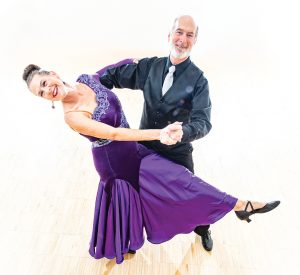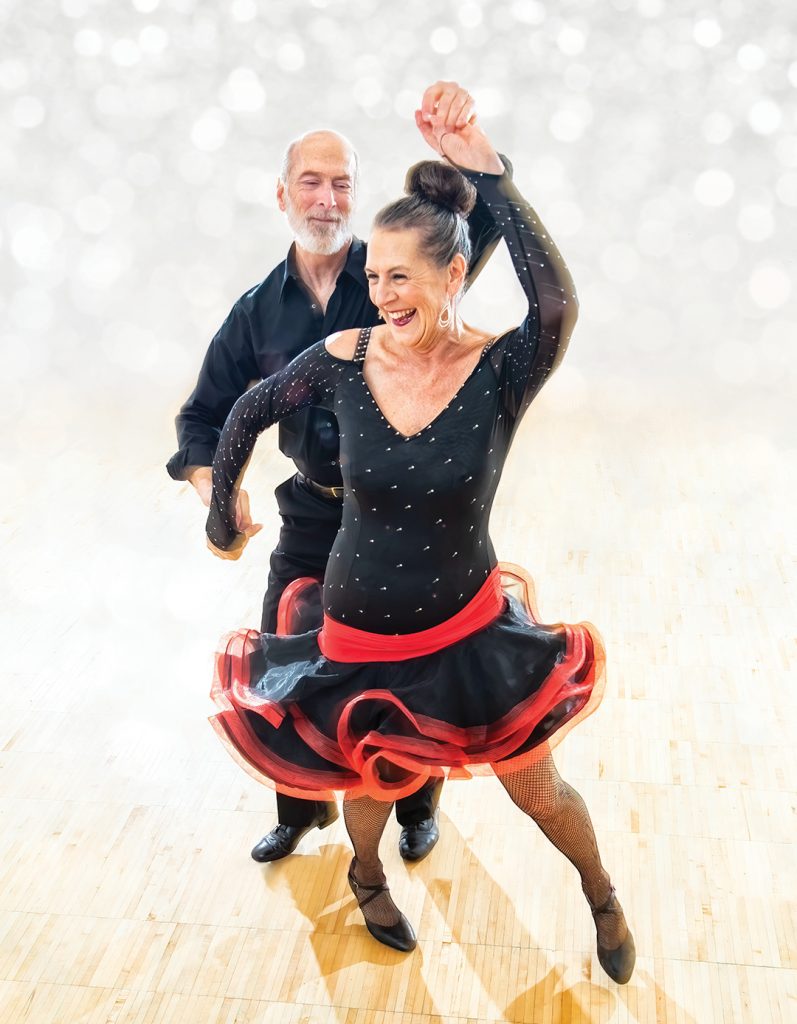With the doo-wop classic “Sh-Boom” by The Chords bouncing off the racquetball court walls, a beaming woman in a ruffled Latin dress swing dances with a silverbearded man in black.
They step toward each other, then apart, swinging their hips and moving from one end of the room to the other in a series of purposeful steps, both smiling ear to ear.
“I just can’t help it,” says the woman, 70-year-old Maryann Kudalis, pausing to catch a breath between dances with friend John Carlson, 71, at the Midtown YMCA in St. Paul. “I’m always happy when I’m dancing.”
Kudalis and Carlson, both Blue Cross members, took up ballroom dancing in their 50s, turning a curiosity into a passion that also serves as a boost to their health and wellness. Research has shown that ballroom dancing can provide both physical and mental health benefits, from better balance to enhanced memory. And as a lowimpact activity with a wide variety of styles to choose from, it’s something older adults can get into and enjoy for many years.
LEARNING A LANGUAGE
Jennelle Donnay, co-founder of Awakened Dance, a Minnesota studio with locations in Anoka and Spring Lake Park, has been teaching ballroom dance for 20 years. She likes to refer to it as a language that you learn to speak with a partner through a series of choreographed steps on the dance floor.
“Every dance has a foundation of steps, and a lot of the different styles can sometimes transfer over into other dances,” Donnay says. “It’s just learning a different basic step for every song, learning how to recognize songs and what category they fit into, and the language so that you can speak it with other people. Even if we don’t speak the same language vocally, the beautiful thing about dance is that we can speak it with anyone.”
There are a variety of ballroom dance styles, such as waltz, foxtrot, tango, and cha-cha. Some, such as a waltz, involve smooth, long strides. Others, such as cha-cha, are more up-tempo and incorporate quicker steps.
Dances are taught at different levels of complexity, Donnay says, with beginners starting at what is known as the “bronze” level. Silver is intermediate, and gold is for advanced, often competitive, dancers. Though learning to dance does require instruction, time, and patience, it’s not as intimidating as it might seem. Donnay says 10 hours of instruction (spaced out over days) is generally enough for a beginner to learn a full dance.
“Dancing is actually easier than most sports and because ballroom dancing is with a partner,” she says. “That helps with things like counterbalance, push and pull, learning together, and from each other.”
FORMING A PARTNERSHIP
Kudalis, a retired teacher who lives in Minneapolis, took her first crack at organized dancing after she and her late husband met an instructor through their work with Rotary International in the early 2000s. She tried salsa dancing and was quickly hooked. As a shy person, it took time to build her confidence.
 “I loved it. It was hard at first because I was always nervous,” Kudalis says. “But I got to know people and developed a community. I learned how to navigate the system and to be comfortable with it.”
“I loved it. It was hard at first because I was always nervous,” Kudalis says. “But I got to know people and developed a community. I learned how to navigate the system and to be comfortable with it.”
Carlson, who retired in 2017 from a 37-year career as a general surgeon in Hastings, Minnesota, started dancing with a group of friends in preparation for a wedding. Though he never enjoyed social dancing, he liked the challenge of ballroom dancing, the structure of it and the connection to music and dance partners.
Though many dancers begin with a spouse, anyone can show up to a group dance session alone. Switching dance partners is a normal part of the process and a good way to meet people and stay social. Carlon’s wife couldn’t dance because of medical issues, so he danced with a friend for years before she, too, was unable to do it. Kudalis had regularly danced with others, but also danced with her husband, until he became ill from diabetes complications. Dancing, and the community she developed through the activity, was actually a big help in coping with his death, she said.
Kudalis and Carlson met at a group session a couple of years ago and formed a partnership to improve their skills and perform at local events. They have mastered seven dances and practice two or three times a week in gyms, racquetball courts, or dance studios.
HEALTHY REWARDS
Social dance, including ballroom dancing, has been the subject of many medical studies that have shown wide ranging health benefits.
A 2016 study from Frontiers in Aging Neuroscience found that social dance could boost an area of the brain associated with memory and could even help prevent the onset of dementia. Another study, in the Journal of Aging and Physical Activity, found a connection between long-term tango dancing and better balance and gait in older adults. Dancing has also been shown to help joint health, retain bone mass, and build strength.
After decades as a medical professional, Carlson knows the benefits of an active lifestyle well and has always tried to exercise regularly. A sports enthusiast, he was involved in adult basketball and softball leagues and still plays competitive volleyball. Dance is an excellent alternative to some of those higher impact activities. It is low risk, high reward — as long as it’s something you enjoy, he says.
“I know volleyball won’t go on forever,” Carlson says. “But dancing, we have people who are in their 80s and 90s in these group lessons. And they are moving better and staying strong. I have experienced a lot of benefits from dancing, both in coordination and strength.”
Kudalis says dancing has helped her maintain a healthy weight, made her stronger, and has also helped ease the symptoms of her osteoarthritis. But most importantly, she says, it brings her joy.
“I can go to any studio, any night,” she says. “They might ask me to dance, or I can ask them to dance. Young, old, tall, short, it doesn’t matter. The people are so kind and we’re all there for the same reason. We’re just there to dance.”


